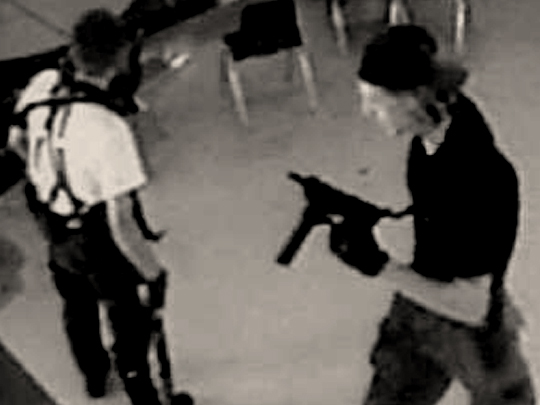Wikimedia Commons / CC-BY-SA-3.0 / GFDL
1 – Columbine High School Massacre
The Columbine High School massacre was a notorious school shooting that occurred on 20 April 1999, at Columbine High School in Jefferson County, Colorado, United States.
At the time, it was the deadliest shooting at a high school in U.S. history.
The perpetrators were twelfth-grade students Eric Harris and Dylan Klebold, who murdered 12 students and one teacher.
Ten students were murdered in the school library, while a further 21 people received gunshot wounds. The shooters committed suicide by shooting themselves in the library.
In addition to the shootings, the attack involved several homemade bombs, with the two largest being placed in the school cafeteria.
Car bombs were also placed in the parking lot, which was intended to divert first responders. However, the bombs in the cafeteria and car park failed to detonate.
A total of 188 rounds of ammunition were fired by the two gunmen during the massacre, with Harris firing nearly twice as much as Klebold.
Local police were heavily criticized for not intervening during the shooting. This inaction resulted in the introduction of a new rapid-deployment tactic to be utilized in active shooter situations.
The FBI concluded mental illness was the reason behind the shooting, with Harris being a clinical psychopath, and Klebold a depressive. The pair had planned the massacre for about a year, wishing to rival the death toll of the Oklahoma City bombing.
In 2001, the HOPE memorial library was built next to the school’s west entrance. A memorial was built in 2007 in honor of those killed in the massacre.
Tragically, the massacre inspired several copycat school shootings.
2 – The Euro Becomes The New ‘Single Currency’ of The European Monetary Union
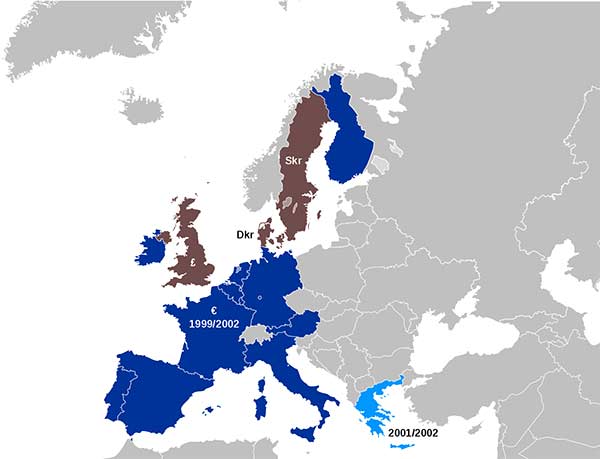
The euro came into existence on 1 January 1999, with it having been a goal of the European Union (EU) since the 1960s.
In 1993, the Maastricht Treaty came into being with the goal of creating an economic and monetary union for all EU states except the UK and Denmark.
At midnight on 1 January 1999, the euro was introduced in a non-physical form. The national currencies of eurozone countries ceased to exist independently, their exchange rates locked at fixed rates against each other.
The conversion rates were determined by the Council of the European Union based on the market rates on 31 December 1998.
Beginning on 1 December 2001, coins and notes were distributed from secure storage, first to large retailers, and then to smaller ones.
In 2009, the Lisbon Treaty finalized the Eurogroup’s political authority alongside the European Central Bank.
3 – Military Coup In Pakistan
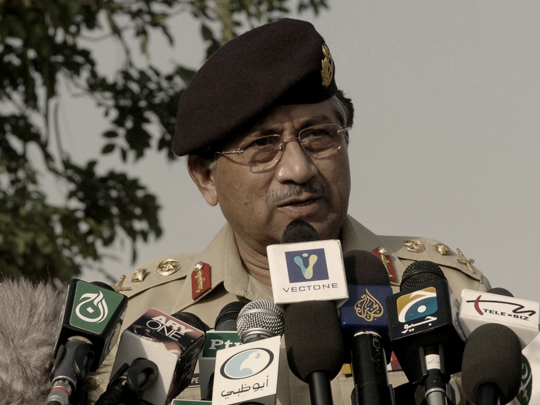
The Pakistani coup d’état was a bloodless coup d’état in which the Pakistani military, under General Pervez Musharraf, seized control of Nawaz Sharif’s government on 12 October 1999.
Musharraf was returning from Sri Lanka when Sharif attempted to relieve him of his command, ordering the Civil Aviation Authority to divert the plane to India.
He then ordered the runways to be closed and the edge lights at the Jinnah International Airport to be turned off.
However, military police seized control of the control tower, allowing the plane to land. Defending Musharraf’s authority, they took control of all key government secretariats throughout the country, placing Sharif and his cabinet under house arrest.
The military police also took control of the state broadcaster, radio, and the entire communications infrastructure, before announcing Nawaz Sharif had been dismissed.
Two days later, General Musharraf declared a state of emergency by issuing a Provisional Constitutional Order that suspending the Constitution of Pakistan.
The Supreme Court of Pakistan validated the martial law declaration, limiting its legality to three years. Meanwhile, Sharif was trialed and convicted for risking the lives of all the passengers on board the plane, receiving life imprisonment.
Musharraf unexpectedly issued a pardon of Nawaz Sharif in December 2000, also allowing immediate members of his family to travel to Saudi Arabia on a private jet.
On 30 April 2002, a national referendum was held on whether Musharraf could continue his rule. He got 98% of the vote in the controversial referendum, with Human Rights groups declaring it to be fraudulent.
President Musharraf imposed martial law again in 2007, having suspended a Chief Justice on charges of corruption and misconduct.
However, it was widely disapproved, leading to mass demonstrations. Ultimately, Musharraf was forced to resign in an attempt to avoid impeachment.
The Supreme Court acquitted Sharif from the hijacking case in 2009, while in 2014, he was also acquitted of money laundering and corruption.
4 – John F. Kennedy Jr., His Wife, and Sister-in-Law Are Killed in a Plane Crash
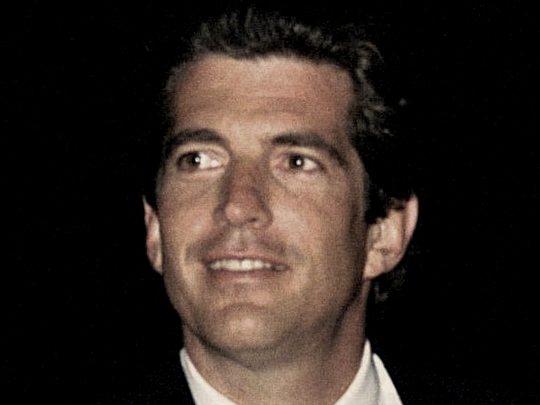
On the evening of 16 July 1999, John F. Kennedy Jr, the son of US President John F. Kennedy, died at age 38 when the single-engine plane he was flying crashed into the Atlantic Ocean off Martha’s Vineyard, Massachusetts.
Also on board was Kennedy’s wife, Carolyn Bessette, and sister-in-law, Lauren Bessette, who both died in the crash.
They had been en route to the marriage of John’s cousin Rory Kennedy in Cape Cod’s Hyannis Port.
At the time of the crash, the poor weather and light conditions meant shore lights or other landmarks were obscured, making visual flight challenging.
Kennedy, who was recovering from a broken ankle, would have had to rely on his instruments for flying, but he had not qualified for a license to fly with instruments only.
The official investigation by the National Transportation Safety Board concluded Kennedy had become disoriented in the dark and hazy night while descending over the water and lost control of his plane.
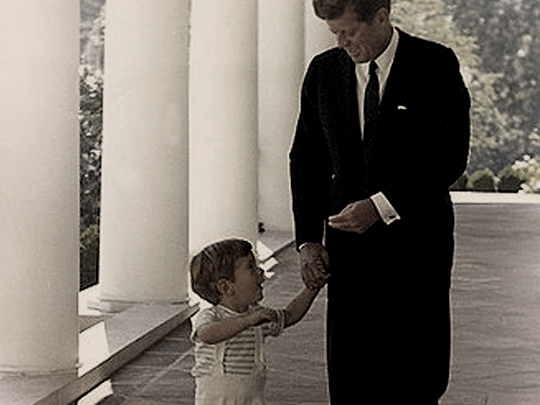
John Jr. was born on 25 November 1960, just a few weeks after his father was elected as the 35th president of the United States.
On his third birthday, he attended the funeral of his assassinated father, memorably saluting his father’s coffin as it passed.
In 1988, he was named the “Sexiest Man Alive” by People magazine. A trained lawyer, he was linked romantically with several celebrities, before marrying Carolyn Bessette, a fashion publicist in September 1996.
On 21 July 1999, Navy divers recovered the three bodies from the wreckage of the plane, about eight miles off the coast of Martha’s Vineyard. The next day, their cremated remains were buried at sea.
5 – The World Awaits The Y2K Bug

The Y2K bug, also known as the Millenium bug, was a type of computer bug related to the formatting and storage of calendar data for dates beginning in the year 2000.
Problems were anticipated because many programs only represented years with the final two digits, potentially making the year 2000 indistinguishable from 1900.
The assumption of a twentieth-century date in such programs could cause various errors, such as the incorrect display of dates and the inaccurate ordering of automated dated records or real-time events.
Without corrective action, long-working systems would break down when the assumed ascending numbering would suddenly become invalid.
People around the world feared the breakdown of computer and financial systems.
However, the anticipated problem was checked and fixed, with companies and organizations around the world upgrading their computer systems.
As a result of the preventative measures taken, few computer failures were reported when the clocks struck midnight on New Year’s Eve 2000, the dawn of a new millennium.
